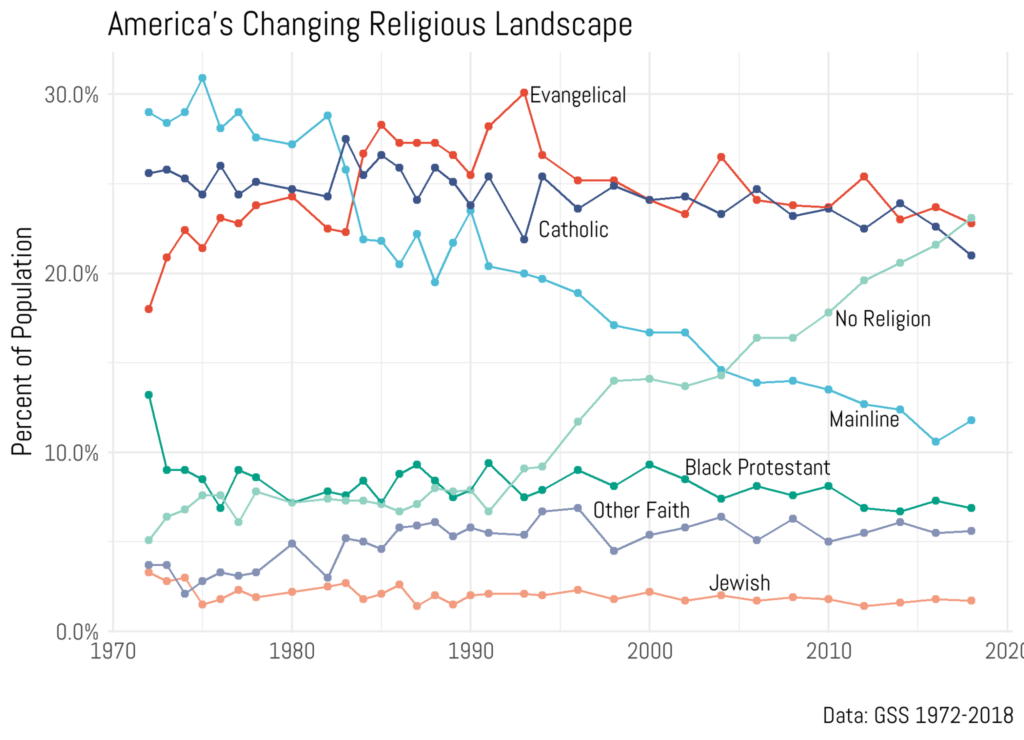Ryan Burge is rather convincing. As an academic (Eastern Illinois University) social scientist-American Baptist pastor, he has a foot in two of the worlds that many of us occupy. He was our guest recently for a day of conversation about 21st-century ministry in light of dramatic changes in attendance and attention patterns.
What he shared with us was both haunting and invigorating.
In short, it will soon be true that some 30% of Americans (and that is much higher the younger you track) describe their preferred religious community as “none”. Of that group, 85% profess an individual faith but choose not to participate in any organized faith community. In fact, many of them see a local church as antithetical to their practice of faith. Oh my.
We have a major problem.
That percentage has been rising dramatically in recent years, while the percentage who attend church on a regular basis in established mainline has been dropping dramatically.

Burge made a convincing case over the course of our day that business as usual will lead most established local churches to their inevitable demise, as those who provide the financial support and attend will soon age out and pass off the scene. We will be left, increasingly, with cavernous buildings filled with fewer and fewer attendees. Viability will become the pressing question.
Megachurches beware, your time is coming as well. The lateral (74% of megachurch attendees came from other churches) and biological (20% of megachurch attendees are biological offspring) growth of the last thirty years will soon wane. Without adaptation, megachurches will face their own reckoning when it comes to the Nones.
Thankfully, Ryan didn’t leave us in despair. He noted that research shows the Nones are actually hungry for and seeking many of the things and experiences that our churches take for granted.
For example, the epidemic of loneliness in the United States is well documented.
When we asked Ryan “what are we to do?”, his first response was quite simple: build community. He underscored how strong the need for connectedness is among young adults, families, empty nesters, senior adults, etc. Much of our ministry model is focused on people already in the fold. If we truly want to engage those outside the church and even the faith, then we must turn our attention toward building community and relationships with those outside our church-centric relationship circles. That probably will not happen in the sanctuary, on a Sunday morning, or even on the property. Instead, our focus must expand toward a seven-day approach that engages people where they are rather than asking them to come to our facilities for a dose of our religion.
Many groups are emerging that can help a congregation rebalance its approach to ministry toward those outside the normal attendance patterns that we associate with faith. Our friends at Fresh Expressions have led the way in helping many congregations engage with their community with intentionality and focus. Recognizing that affinity groups are the new normal for those outside the church is a start toward engaging people with a message of hope and reconciliation. In his book From the Steeple to the Street,
Travis Collins invites churches to move toward their community, rather than wait for them to show up at our religious gatherings.
If we are to engage with the Nones in a respectful and thoughtful manner, then we must start by listening to their critiques of our old models and showing them that our message of a beloved community centered in Christ may actually be what they are looking for. Of course, we may have to admit that much of what passes for community in congregations is a version of self-selecting with like-minded people who have retreated from engaging a world that frightens and mystifies us. For all our talk about diversity, churches are actually rather homogenous communities.

We need the spirit of the Apostle Paul to invade our midst. Unafraid to venture outside the normal boundaries of religious identity, he saw a world filled with diverse people unconsciously longing for the abundant life Jesus embodied. Following the example of Jesus, he led the early church into the marketplace and the public places to engage whole communities with the Good News. Jesus and Paul practiced a kind of intentional diversity that most of our churches would be uncomfortable with. Unwilling to huddle behind the walls of religious buildings and traditions, they led the church into the world and taught us about adapting the Gospel to answer the questions of the day.
The Nones are sending a clear signal that the practices of 19th and 20th-century attractional congregational life will not be sufficient to engage them. Instead, as we navigate our third decade of ministry in the 21st century, we must adapt and take the Good News of Jesus to them in a loving, respectful, and winsome fashion. Anything less, and we will witness an unprecedented shrinkage of the American church, and that is a legacy none of us wants to be remembered for.

I am waiting for an article with ideas on HOW to go about this. Tactical tips